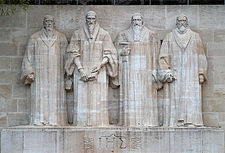
Back Kongregasionalistiese Kerk Afrikaans أبرشانيون Arabic ابرشانيون ARZ Конгрешанство Bulgarian Església congregacional Catalan Kongregační církve Czech Kongregationalisterne Danish Kongregationalistische Kirchen German Kongregaciismo Esperanto Iglesia congregacional Spanish

| Part of a series on |
| Reformed Christianity |
|---|
 |
|
|
Congregationalism (also Congregationalist churches or Congregational churches) is a Reformed (Calvinist) tradition of Protestant Christianity in which churches practice congregational government. Each congregation independently and autonomously runs its own affairs. These principles are enshrined in the Cambridge Platform (1648) and the Savoy Declaration (1658), Congregationalist confessions of faith.[1][2][3] The Congregationalist Churches are a continuity of the theological tradition upheld by the Puritans.[4] Their genesis was through the work of Congregationalist divines Robert Browne, Henry Barrowe, and John Greenwood.[5]
In the United Kingdom, the Puritan Reformation of the Church of England laid the foundation for these churches. In England, the early Congregationalists were called Separatists or Independents to distinguish them from the similarly Calvinistic Presbyterians, whose churches embrace a polity based on the governance of elders; this commitment to self-governing congregations was codified in the Savoy Declaration.[2] Congregationalism in the United States traces its origins to the Puritans of New England, who wrote the Cambridge Platform of 1648 to describe the autonomy of the church and its association with others.[6] Within the United States, the model of Congregational churches was carried by migrating settlers from New England into New York, then into the Old Northwest, and further.
The Congregationalist tradition has a presence in the United States, the United Kingdom, Ireland, Canada, South Africa, Australia, New Zealand, and various island nations in the Pacific region. It has been introduced either by immigrant dissenters or by missionary organizations such as the London Missionary Society. A number of evangelical Congregational churches are members of the World Evangelical Congregational Fellowship. Congregationalism, as defined by the Pew Research Center, is estimated to represent 0.5 percent of the worldwide Protestant population.[7]
- ^ Rohr, John Von (4 August 2009). Shaping of American Congregationalism 1620-1957. The Pilgrim Press. ISBN 978-0-8298-2077-5.
Although the Savoy Declaration's confessin of faith was based largely upon that of Westminster, the section entitled "The Institution of Churches" became an important late seventeenth-century document depicting the congregational form of church order.
- ^ a b Fields, C. Ryan (6 February 2024). Local and Universal: A Free Church Account of Ecclesial Catholicity. InterVarsity Press. ISBN 978-1-5140-0672-6.
After the doctrinal exposition there follows a section titled "The Institution of Churches, and the Order Appointed in Them by Jesus Christ," which further specifies how their polity differs from the Presbyterian divines.
- ^ Davie, Martin; Grass, Tim; Holmes, Stephen R.; McDowell, John; Noble, T.A., eds. (21 April 2016). New Dictionary of Theology: Historical and Systematic (Second Edition). Inter-Varsity Press. ISBN 978-1-78359-457-3.
Cambridge Platform (1648) and Savoy Declaration (1658) were the fundamental formularies of, respectively, American and English Congregationalism. In doctrine they essentially reproduced the Westminster Confession, with the changes needed to provide for a church polity of independent congregations (Schaff; Leith; W. Walker, The Creeds and Platforms of Congregationalism, New York, 1893).
- ^ Melton, J. Gordon (2005). Encyclopedia of Protestantism. Infobase Publishing. p. 161. ISBN 978-0-8160-6983-5.
- ^ Pastoor, Charles; Johnson, Galen K. (28 September 2009). The A to Z of the Puritans. Scarecrow Press. p. 84. ISBN 978-0-8108-7039-0.
- ^ Hillerbrand, Hans J. (2 August 2004). Encyclopedia of Protestantism: 4-volume set. Routledge. ISBN 978-1-135-96027-8.
Congregationalists formally embraced the Westminster Confession, apart from its Presbyterian polity, in the Cambridge Platform in America, and the Savoy Declaration in England.
- ^ "Global Christianity: A Report on the Size and Distribution of the World's Christian Population" (PDF). Pew Forum on Religion & Public Life. Archived from the original (PDF) on 2013-08-05. Retrieved 2014-05-14.
© MMXXIII Rich X Search. We shall prevail. All rights reserved. Rich X Search